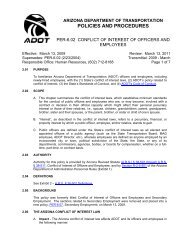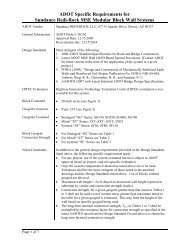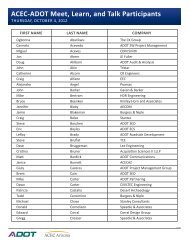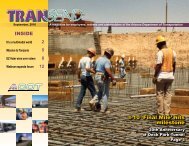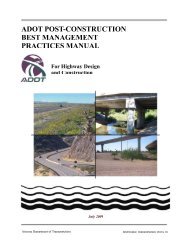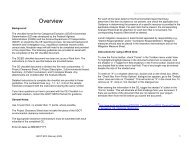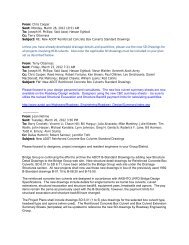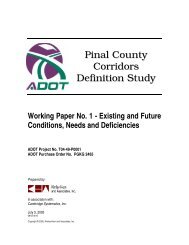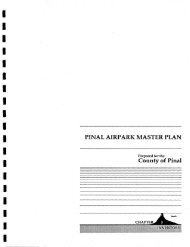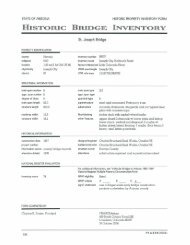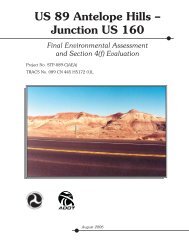I-10 Twin Peaks Traffic Interchange, Environmental Assessment
I-10 Twin Peaks Traffic Interchange, Environmental Assessment
I-10 Twin Peaks Traffic Interchange, Environmental Assessment
You also want an ePaper? Increase the reach of your titles
YUMPU automatically turns print PDFs into web optimized ePapers that Google loves.
Project Purpose and Need October 2005<br />
the CFPO. Much of this development occurred within the Cortaro Road and Silverbell<br />
Road corridors. At the time the Plan Update was being completed, traffic congestion was<br />
concentrated along Cortaro Road, Ina Road, and Orange Grove Road in the vicinity of<br />
I-<strong>10</strong> and at major arterial roadway intersections near retail centers.<br />
Congestion of roadways and intersections is measured by capacity analyses according to<br />
procedures contained in the 2000 Highway Capacity Manual. Capacity is defined by<br />
Level of Service (LOS) which is expressed as letters A to F (LOS A representing the best<br />
operating conditions and LOS F the worst). During morning and evening peak hour<br />
traffic, LOS D is considered acceptable for the urban situation characteristic of the area<br />
of the <strong>Twin</strong> <strong>Peaks</strong> Road TI. These LOS conditions are graphically depicted in Figure 2-1.<br />
At the time of the Plan Update, Cortaro Road suffered some of the poorest operating<br />
conditions of any arterial in the Town of Marana. Cortaro Road had the highest number<br />
of segments operating at LOS F (4) and the highest percentage of segments operating at<br />
LOS F (80%) within the Town of Marana. Since the Plan Update, Cortaro Road, Cortaro<br />
Farms Road, and Ina Road west of I-<strong>10</strong> were widened and additional widening is planned<br />
for Cortaro Farms Road east of I-<strong>10</strong>. This would continue to provide congestion relief in<br />
the area, but because Cortaro Farms Road crosses the UPRR at-grade, frequent passing<br />
trains cause substantial delays to motorists. According to PAG, approximately 50 to 65<br />
UPRR trains pass through the area per day.<br />
<strong>Traffic</strong> forecasts for the year 2030 were developed for this project using the regional<br />
transportation demand model. This information is presented in Table 2-1. The 2030<br />
projected ADT volumes presented in Table 2-1 are developed from 24-hour traffic counts<br />
of existing traffic, projected development (both residential and employment) in the<br />
region, and proposed improvements to other roadways in the regional transportation<br />
network. The regional transportation demand model then forecasts traffic based on<br />
drivers selecting the paths of least resistance from projected origins (residential areas) to<br />
destinations (areas of employment and other destinations). According to the forecasts, a<br />
<strong>Twin</strong> <strong>Peaks</strong> Road TI would absorb a substantial amount of traffic from other roadways in<br />
the area. As shown in Table 2-1, 7,600 and 5,<strong>10</strong>0 vehicles are displaced from Cortaro<br />
Road and Cortaro Farms Road west and east of I-<strong>10</strong>, respectively. However, Silverbell<br />
Road would experience the greatest relief. On Silverbell Road, 12,300 and 8,300 vehicles<br />
are displaced north and south of Cortaro Road, respectively.<br />
A grade-separation at the UPRR would prevent drivers from experiencing train-related<br />
delays on <strong>Twin</strong> <strong>Peaks</strong> Road and would reduce congestion on other local roadways. It is<br />
important to note that traffic impacts related to railroad crossings are difficult to analyze<br />
in both the traffic capacity software (which produces LOS) and the transportation demand<br />
model (which forecasts traffic). It is likely that the transportation demand model volumes<br />
presented in Table 2-1 underestimate the amount of traffic that the <strong>Twin</strong> <strong>Peaks</strong> Road TI<br />
would displace, because drivers would favor grade-separated railroad crossings over atgrade<br />
crossings.<br />
Interstate <strong>10</strong> <strong>Traffic</strong> <strong>Interchange</strong> at<br />
<strong>Twin</strong> <strong>Peaks</strong>/Linda Vista<br />
2-3<br />
Project No.: NH-0<strong>10</strong>-D (AIW)<br />
TRACS No.: <strong>10</strong> PM 236 H5838 01D



